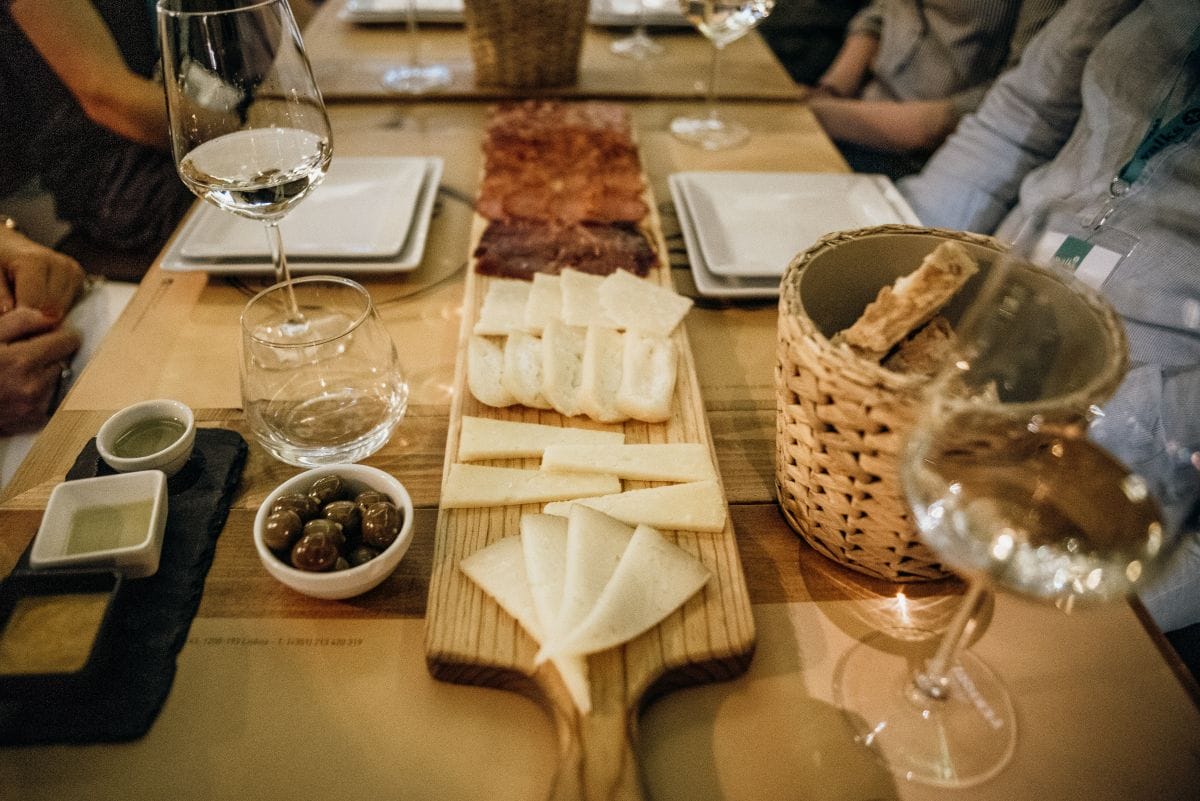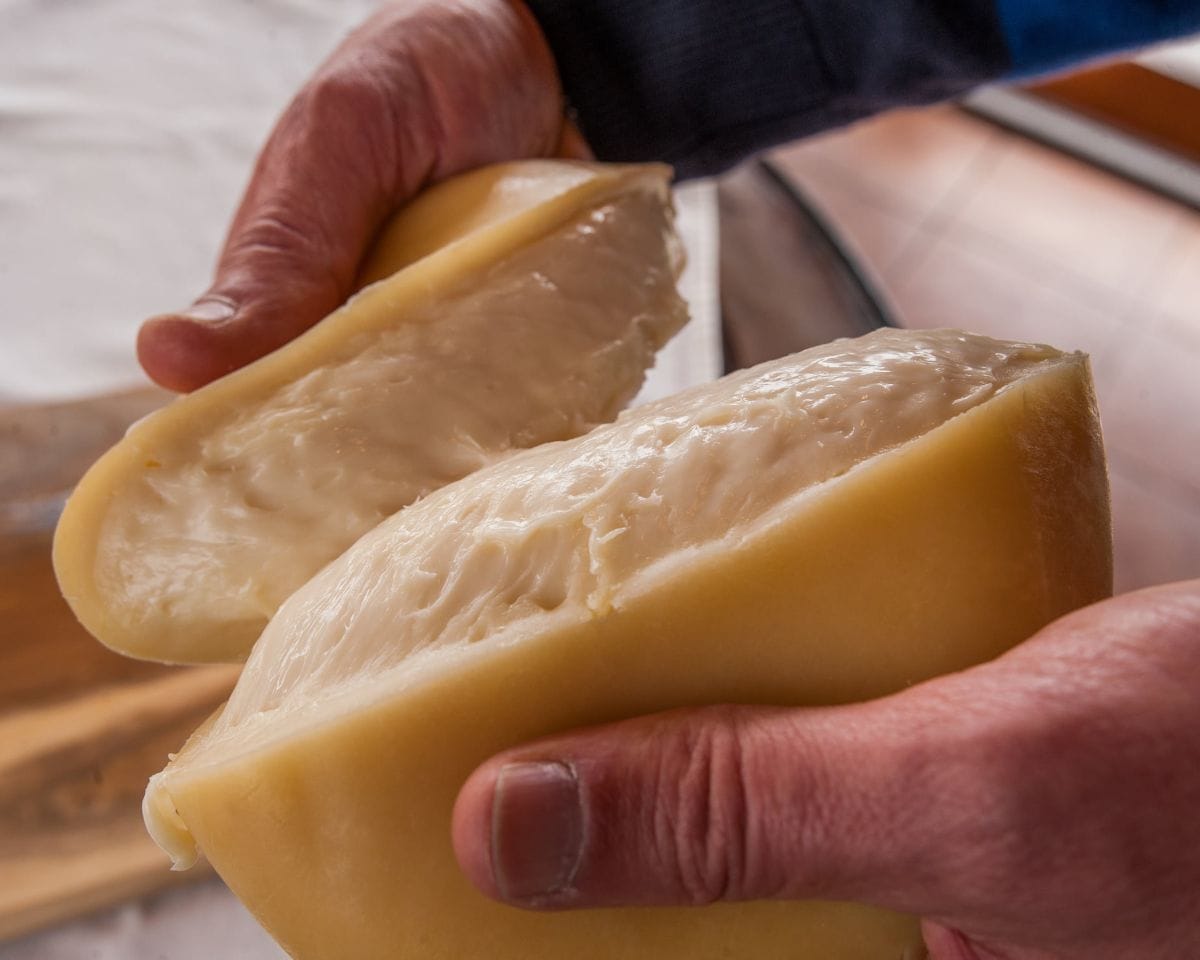Last Updated on November 26, 2025 by Emma Fajcz | Published: June 19, 2019
Creamy, dry, strong or mild—whatever you’re into, there’s a cheese in Portugal made for you.
Just like Portuguese wine, every region in Portugal has its own cheese. Many even have a Protected Designation of Origin, which ensures the cheese is produced in that region alone using traditional methods and ingredients.
You don’t need to travel too far to try a selection of Portuguese cheeses, as most of them are available in local restaurants or supermarkets. If this is uncharted territory to you, don’t worry—we’ve put together a list of the best cheeses to try in Portugal, including tips on how to eat them.

Queijo Serra da Estrela
When speaking of Portuguese cheese, Queijo Serra da Estrela always comes out on top. Produced in the region of Serra da Estrela, this cheese is famous for its creamy texture and intense smell. The traditional variety uses sheep’s milk, but you can find other versions that have goat’s milk too.
This variety holds the title of the oldest Portuguese cheese, with historical records of it dating back to the 12th century—so there’s no wonder that it’s such an iconic element of the country’s cuisine.
If you’ve tried the pastéis de bacalhau from Casa Portuguesa do Pastel de Bacalhau, you’ve already had a sample of Queijo Serra da Estrela, as it’s in the filling. You might also see it at local festivals, where it’s often served in sandwiches with presunto (Portuguese cured ham). And for something sweet, some locals like to pair it with a bit of marmelada (quince paste).
How to eat it:
- Cut a circular hole out of the top of the rind and use a spoon to spread this delicious cheese on crackers or fresh bread.

Queijo de Cabra Transmontano
Queijo de Cabra Transmontano isn’t your typical goat’s cheese. Although it’s made from goat’s milk, this cheese is hard and slightly spicy. The longer it ages, the spicier it gets.
The name transmontano comes from the region where it’s made: Trás-os-Montes. To make this artisanal cheese official, locals can only use milk from the regional breed of Serrana goats.
Literally meaning “behind the mountains,” Trás-os-Montes is located all the way at the northeast corner of Portugal, surrounded by mountains that have historically isolated it from the rest of the country. One result is that the area has developed its own distinctive cuisine, featuring not only Queijo de Cabra Transmontano but also lots of hearty stews and meat-based specialties.
How to eat it:
- You can cut it into thin slices to eat with bread or pair it with a mixed berry jam.

Queijo Rabaçal
Hailing from Rabaçal, a small village near Coimbra, this cheese combines sheep’s milk and goat’s milk. It’s subtle, similar to a fresh goat’s cheese, but with its own distinctive flavor. This is partly due to the fact that the sheep and goats who produce the milk it’s made from consume large quantities of erva de santa maria, a wild herb that’s related to thyme and common in the region.
Unlike most Portuguese cheese varieties, Queijo Rabaçal is made with animal rennet rather than vegetable rennet. This means that it’s not technically vegetarian.
Cured for at least 20 days, its texture can vary from semi-hard to hard. In some places, you can also find it as a fresh cheese, which doesn’t undergo the ripening process.
How to eat it:
- You can eat it as a starter with a bit of bread or for dessert drizzled with some honey.

Queijo de Azeitão
Similar to Serra da Estrela, Queijo de Azeitão is also creamy, but milder in flavor. It’s made from raw sheep’s milk, and thistle flowers are used in place of animal rennet to solidify the cheese.
This cheese gets its name from Azeitão, a civil parish located about 40 minutes south of Lisbon, but today it’s produced throughout the surrounding areas of Setúbal, Sesimbra, and Palmela as well.
In Palmela you can visit the Museu do Ovelheiro (Sheep Farmer’s Museum) to learn more about its production, participate in cheese making workshops, and even meet the Saloia sheep who provide the milk it’s made from.
How to eat it:
- Cut a hole in the top of the cheese, then scoop it out with a spoon—just like Queijo Serra da Estrela.

Queijo de Nisa
Queijo de Nisa is a semi-hard type of cheese from the Alentejo region. Like Queijo de Azeitão, it’s made with vegetable rennet and raw sheep’s milk, in this case from the Merina Branca breed. It’s produced in the district of Portalegre, which includes the small town of Nisa that it’s named after.
Queijo de Nisa has a relatively strong and slightly acidic flavor. It’s famous across the country for its unique taste and artisanal origins; there are still only a few small producers who make it. In the past it was also an indispensable source of protein for the local population.
How to eat it:
- Cut it into slices and eat it as a petisco paired with a glass of Alentejo wine.
Cheese and crackers are a great snack to order in Portugal.
Queijo de Évora
As you can probably guess, Queijo de Évora comes from Évora, the capital of the Alentejo region. It’s made with milk from the same type of sheep as Queijo de Nisa (Merina Branca), but with its own production process that yields a noticeably different result.
Aged for either 30 or 90 days, Queijo de Évora has a hard or semi-hard texture and a salty flavor. The older varieties often have a bit of a spicy kick.
In many Portuguese restaurants, it’s served as part of the couvert (an array of small starters). Traditionally it was preserved in olive oil, and you can still find it served this way in some places today.
How to eat it:
- Slice the cheese and eat it with some bread or just by itself. It’s okay to eat the rind.

Queijo Serpa
Queijo Serpa is an award-winning cheese that’s also from Alentejo and made with raw sheep’s milk. It comes from the town of Serpa in the Beja district, located about half an hour’s drive from the border with Spain. Aged for 30 days, it has a fairly soft texture, strong flavor, and flexible rind.
One of the most interesting facts about Queijo Serpa is that religious traditions are woven into its production and consumption. For example, the filtering cloth has to be folded exactly 40 times, and the finished wheel of cheese should only be cut using four movements of the knife.
How to eat it:
- After making the customary four cuts, pair slices of Queijo Serpa with freshly baked pão alentejano for a regional treat.

Requeijão
Requeijão is a light Portuguese cheese, similar to ricotta. You’ll find it in most supermarkets sold in plastic containers. It’s typically made from cow’s milk and has a much more subtle flavor than the other cheeses on this list.
Although requeijão is a generic type of cheese, there’s also a specific variety from Serra da Estrela that has Protected Designation of Origin. It’s made from the whey that’s separated out during the production of regular Serra de Estrela cheese. Like ricotta, it’s high in protein and low in fat.
Traditionally, requeijão was sometimes mixed into milk, coffee, or soup to add extra protein and nutritional value. Today it’s often sprinkled with salt and pepper and served with salad, though it’s also common to eat it for dessert.
How to eat it:
- For a classic sweet take on requeijão, pair it with pumpkin jam, nuts, and Port wine.

Queijo São Jorge
If you like cheeses with a spicy kick, Queijo São Jorge is the perfect choice for you. Also known as Queijo da Ilha (island cheese), it comes from the island of São Jorge in the Azores.
Unlike most cheeses from the mainland, this cheese is made exclusively with cow’s milk. It has a semi-hard texture and an intense nutty aroma that grows stronger with age. When buying it from a shop, you can get it whole, cut into wedges, or shredded (ralado).
Along with canned tuna and espécies (spiced cookies), this cheese is one of the most typical products from São Jorge. In fact, the island is renowned for its dairy products in general, and is famously home to more cows than people.
How to eat it:
- This cheese is delicious by itself, but it’s also a great addition to sandwiches, salads, and pasta.

Queijo do Pico
Queijo do Pico also comes from the Azores, but from a different island: Ilha do Pico, home to the highest mountain in Portugal (which also happens to be a volcano). Its main ingredient is traditionally cow’s milk, although some varieties might have goat’s milk as well. Queijo do Pico is softer than Queijo São Jorge and has a similar texture to Gouda.
Queijo do Pico likely dates back to at least the late 1700s, and its specific production methods have been passed down over the centuries to preserve its traditional form. It’s one of the most well-known and widely loved cheeses from the Azores, perhaps second only to Queijo São Jorge (though of course that’s subjective).
How to eat it:
- You can enjoy Queijo do Pico as a snack, starter, or dessert—ideally accompanied by a local wine from Pico.

The best experiences for cheese lovers in Portugal
We’re big fans of food-focused activities, and in Portugal there’s no shortage of fun things to do for cheese lovers.
Whether you want to shop, eat, get a look behind the scenes, or all three, here are a few tips and recommendations.

Learn how Portuguese cheese is made
No matter which part of Portugal you’re in, you can likely find a local dairy farm or cheese factory that offers guided tours.
For example, in Penalva do Castelo you can visit Parador Casa da Ínsua to participate in a hands-on cheese making workshop and learn how to make the legendary Queijo Serra da Estrela step by step.
Visit a small queijaria like Monte da Vinha in Évora or a larger factory like Uniqueijo in São Jorge to tour the facilities, see the production process up close, and sample the finished product.
Tip:
- Make sure to book your tour or workshop in advance, as most places require advance notice for these types of experiences.

Shop for a selection of Portuguese cheeses
If you don’t have time to go straight to the source, you can also shop for Portuguese cheeses at gourmet shops like Manteigaria Silva or the aptly named Queijaria, both in central Lisbon. Buy a few different types to sample right away or pack some into your suitcase—cheese makes for a wonderful souvenir.
Can’t make it to Portugal? Luckily, it’s also possible to find many of the country’s best cheeses online. Whether you’re shopping in person or from afar, here are a few words and phrases that will come in handy:
- Cheese – Queijo
- Sheep – Ovelha
- Goat – Cabra
- Cow – Vaca
- Fresh – Fresco
- Cured/aged – Curado
- Mild flavor – Sabor suave
- Strong flavor – Sabor forte
Tip:
- If you don’t do dairy, you’ll be happy to know that there are some spectacular plant-based cheeses made in Portugal. The most prominent brand is Muka, whose cashew-based cured cheeses are truly incredible. Keep an eye out for it at gourmet shops and on restaurant menus.

Order a Portuguese cheese board
When in Portugal, the best way to sample local cheeses is to order a cheese board, or tábua de queijos, at a restaurant. It’s the perfect introduction to Portuguese cheese, as you’ll get to try a variety of different types at once.
You can also order a mixed board (tábua mista), which comes with both cheese and embutidos, or cured meats, including traditional Portuguese sausages. A few of our favorite places to enjoy delicious tábuas in Lisbon are Momentos (which is also a cheese and wine shop), By the Wine, and Taberna at Bairro do Avillez.

Portuguese cheese FAQ
What wine should I pair with Portuguese cheese?
That depends on the cheese. It’s hard to go wrong when pairing Portuguese wines and cheeses, but we do have our favorites. For something special, try pairing espumante (Portuguese sparkling wine) with Queijo São Jorge or Tawny Port with Queijo Serra da Estrela.
We’re also partial to cheese and wine pairings from the same region; for example, Queijo do Pico with one of the volcanic wines produced on the same island, or Queijo de Évora with white wine from Alentejo.

Where can I buy authentic Portuguese cheese in Lisbon?
For a curated selection of Portuguese cheeses, head to a specialty shop—some of our favorites in Lisbon are Manteigaria Silva, Momentos, and Queijaria.
However, you can also find high-quality cheeses at most Portuguese supermarkets. Keep an eye out for the DOP (Protected Designation of Origin) label and the varieties listed above to ensure that your choice is authentic and artisanal.
Specialty shops are a great place to pick up Portuguese cheese and other artisanal products.
What traditional Portuguese dishes are made with local cheeses?
In Portugal it’s very common to eat cheese on its own, either as a starter or a simple dessert. This is especially true for celebrated regional cheeses like Queijo Serra da Estrela and Queijo de Évora.
Requeijão is sometimes used in recipes for sweets like queijadas, but the other cheeses on this list are more likely to be found as an appetizer or on a cheese board. That said, you can always upgrade a recipe like bacalhau gratinado with shredded Queijo São Jorge, or make a rich cheesy sauce from Queijo Serra da Estrela.

Why stop at cheese? Dive deeper into Lisbon’s culinary scene on our signature Ultimate Lisbon Food & History Tour of Baixa & Chiado, starting with coffee and pastries at a historic bakery and a visit to the city’s oldest grocery store to learn about Portugal’s beloved bacalhau. Sip cherry liqueur at a 130-year-old family-run shop, feast on regional favorites like pork sandwiches and cod, and end with the perfect pastel de nata. Join us and taste your way through the true heart of Lisbon.








